Hydroclimate Variations across North-Central China during the Past 530 Years and Their Relationships with Atmospheric Oscillations
Abstract
1. Introduction
2. Materials and Methods
2.1. Study Region
2.2. Climate Data and MADA Data
2.3. Tree-Ring Data and DWI Data
2.4. Methods
3. Results and Discussion
3.1. The scPDSI Reconstruction
3.2. The Comparison with Other Hydroclimate Reconstructions
3.3. The Spatial Representation of Our Reconstruction
3.4. Relationships with Large-Scale Climate Modes
4. Conclusions
Author Contributions
Funding
Institutional Review Board Statement
Informed Consent Statement
Data Availability Statement
Conflicts of Interest
References
- Dai, A. Increasing drought under global warming in observations and models. Nat. Clim. Chang. 2012, 3, 52–58. [Google Scholar] [CrossRef]
- Feng, S.; Fu, Q. Expansion of global drylands under a warming climate. Atmos. Chem. Phys. 2013, 13, 10081–10094. [Google Scholar] [CrossRef]
- Huang, J.P.; Yu, H.P.; Guan, X.D.; Wang, G.Y.; Guo, R.X. Accelerated dry land expansion under climate change. Nat. Clim. Chang. 2016, 6, 166–171. [Google Scholar] [CrossRef]
- Sheffield, J.; Wood, E.F.; Roderick, M.L. Little change in global drought over the past 60 years. Nature 2012, 491, 435–438. [Google Scholar] [CrossRef] [PubMed]
- Greve, P.; Orlowsky, B.; Mueller, B.; Sheffield, J.; Seneviratne, S.I. Global assessment of trends in wetting and drying over land. Nat. Geosci. 2014, 7, 716–721. [Google Scholar] [CrossRef]
- Yu, M.; Li, Q.; Hayes, M.J.; Svoboda, M.D.; Heim, R.R. Are droughts becoming more frequent or severe in China based on the standardized precipitation evapotranspiration index: 1951–2010? Int. J. Climatol. 2014, 34, 545–558. [Google Scholar] [CrossRef]
- Chen, H.; Sun, J. Changes in drought characteristics over China using the standardized precipitation evapotranspiration index. J. Clim. 2015, 28, 281–299. [Google Scholar] [CrossRef]
- Jiang, J.; Jiang, D.B.; Lin, Y.H. Changes and projection of dry/wet areas over China. Chin. J. Atmos. Sci. 2017, 41, 43–56. [Google Scholar] [CrossRef]
- Wang, W.; Zhu, Y.; Xu, R.; Liu, J. Drought severity change in China during 1961–2012 indicated by SPI and SPEI. Nat. Hazards 2015, 75, 2437–2451. [Google Scholar] [CrossRef]
- Trenberth, K.E.; Dai, A.; Schrier, G.V.D.; Jones, P.D.; Barichivich, J.; Briffa, K.R.; Sheffield, J. Global warming and changes in drought. Nat. Clim. Chang. 2014, 4, 17–22. [Google Scholar] [CrossRef]
- Zou, X.K.; Zhai, P.M.; Zhang, Q. Variations in droughts over China: 1951–2003. Geophys. Res. Lett. 2005, 32, L04707. [Google Scholar] [CrossRef]
- Ma, Z.G.; Fu, C.B.; Yang, Q.; Zheng, Z.Y.; Lü, M.X.; Li, M.X.; Duan, Y.W.; Chen, L. Drying trend in northern China and its shift during 1951–2016. Chin. J. Atmos. Sci. 2018, 42, 951–961. [Google Scholar] [CrossRef]
- Ma, Z.G.; Fu, C.B.; Zhou, T.J.; Yan, Z.W.; Li, M.X.; Zheng, Z.Y.; Chen, L.; Lv, M.X. Status and Ponder of Climate and Hydrology Changes in the Yellow River Basin. Bull. Chin. Acad. Sci. 2020, 35, 52–60. [Google Scholar] [CrossRef]
- Li, J.B.; Xie, S.P.; Cook, E.R.; Chen, F.H.; Shi, J.F.; Zhang, D.D.; Fang, K.Y.; Gou, X.H.; Li, T.; Peng, J.F.; et al. Deciphering human contributions to Yellow River flow reductions and downstream drying using centuries-long tree ring records. Geophys. Res. Lett. 2019, 46, 898–905. [Google Scholar] [CrossRef]
- Yang, B.; Qin, C.; Bräuning, A.; Osborn, T.J.; Trouet, V.; Ljungqvist, F.C.; Esper, J.; Schneider, L.; Grießinger, J.; Büntgen, U.; et al. Long-term decrease in Asian monsoon rainfall and abrupt climate change events over the past 6700 years. Proc. Natl. Acad. Sci. USA 2021, 118, e2102007118. [Google Scholar] [CrossRef]
- Fang, K.Y.; Guo, Z.T.; Chen, D.L.; Linderholm, W.H.; Li, J.B.; Zhou, F.F.; Guo, G.Y.; Dong, Z.P.; Li, Y.J. Drought variation of western Chinese Loess Plateau since 1568 and its linkages with droughts in western North America. Clim. Dyn. 2017, 49, 3839–3850. [Google Scholar] [CrossRef]
- Liu, Y. Recent anthropogenic curtailing of Yellow River runoff and sediment load is unprecedented over the past 500 years. Chin. Sci. Bull. 2020, 65, 3504–3505. (In Chinese) [Google Scholar] [CrossRef]
- Li, Q.; Liu, Y.; Nakatsuka, T.; Song, H.; McCarroll, D.; Yang, Y.; Qi, J. The 225-year precipitation variability inferred from tree-ring records in Shanxi Province, the North China, and its teleconnection with Indian summer monsoon. Glob. Planet Chang. 2015, 132, 11–19. [Google Scholar] [CrossRef]
- Li, Q.; Liu, Y.; Nakatsuka, T.; Fang, K.Y.; Song, H.M.; Liu, R.S.; Sun, C.F.; Li, G.; Wang, K. East Asian Summer Monsoon moisture sustains summer relative humidity in the southwestern Gobi Desert, China: Evidence from δ18O of tree rings. Clim. Dyn. 2019, 52, 6321–6337. [Google Scholar] [CrossRef]
- Yang, B.; Kang, S.Y.; Ljungqvist, F.C.; He, M.H.; Yan, Z.; Qin, C. Drought variability at the northern fringe of the Asian summer monsoon region over the past millennia. Clim. Dyn. 2014, 43, 845–859. [Google Scholar] [CrossRef]
- Yang, B.; Wang, J.L.; Liu, J.J.; He, M.H.; Melvin, T.M.; Osborn, T.J.; Briffa, K.R. A 1556 year-long early summer moisture reconstruction for the Hexi Corridor, Northwestern China. Sci. China Earth Sci. 2019, 62, 953–963. [Google Scholar] [CrossRef]
- Chen, F.; Xu, Q.; Chen, J.; Birks, H.J.B.; Liu, J.; Zhang, S.; Jin, L.; An, C.; Telford, R.J.; Cao, X.; et al. East Asian summer monsoon precipitation variability since the last deglaciation. Sci. Rep. 2015, 5, 11186. [Google Scholar] [CrossRef] [PubMed]
- Li, J.; Dodson, J.; Yan, H.; Zhang, D.D.; Zhang, X.; Xu, Q.; Lee, H.F.; Pei, Q.; Cheng, B.; Li, C.; et al. Quantifying climatic variability in monsoonal northern China over the last 2200 years and its role in driving Chinese dynastic changes. Quat. Sci. Rev. 2017, 159, 35–46. [Google Scholar] [CrossRef]
- Ma, J.; Edmunds, W.M. Groundwater and lake evolution in the Badain Jaran Desert ecosystem, Inner Mongolia. Hydrogeol. J. 2006, 14, 1231–1243. [Google Scholar] [CrossRef]
- Zhou, A.; Sun, H.; Chen, F.; Zhao, Y.; An, C.; Dong, G.; Wang, Z.; Chen, J. High-resolution climate change in mid-late Holocene on Tianchi Lake, Liupan Mountain in the Loess Plateau in central China and its significance. Chin. Sci. Bull. 2010, 55, 2118–2121. [Google Scholar] [CrossRef]
- Liu, J.B.; Chen, F.H.; Chen, J.H.; Xia, D.S.; Xu, Q.H.; Wang, Z.L.; Li, Y.C. Humid medieval warm period recorded by magnetic characteristics of sediments from Gonghai Lake, Shanxi, North China. Chin. Sci. Bull. 2011, 56, 2464–2474. [Google Scholar] [CrossRef]
- Zhang, P.; Cheng, H.; Edwards, R.L.; Chen, F.; Wang, Y.; Yang, X.; Liu, J.; Tan, M.; Wang, X.; Liu, J.; et al. A Test of Climate, Sun, and Culture Relationships from an 1810-Year Chinese Cave Record. Science 2008, 322, 940–942. [Google Scholar] [CrossRef]
- Tan, L.; Cai, Y.; An, Z.; Edwards, R.L.; Cheng, H.; Shen, C.C.; Zhang, H. Centennial- to decadal-scale monsoon precipitation variability in the semi-humid region, northern China during the last 1860 years: Records from stalagmites in Huangye Cave. Holocene 2010, 21, 287–296. [Google Scholar] [CrossRef]
- Cai, Y.; Tan, L.; Cheng, H.; An, Z.; Edwards, R.L.; Kelly, M.J.; Kong, X.; Wang, X. The variation of summer monsoon precipitation in central China since the last deglaciation. Earth Planet Sci. Lett. 2010, 291, 21–31. [Google Scholar] [CrossRef]
- Chen, F.H.; Yu, Z.C.; Yang, M.L.; Ito, E.; Wang, S.; Madsen, D.B.; Huang, X.; Zhao, Y.; Sato, T.; John, B.; et al. Holocene moisture evolution in arid central Asia and its out-of-phase relationship with Asian monsoon history. Quat. Sci. Rev. 2008, 27, 351–364. [Google Scholar] [CrossRef]
- Chen, F.H.; Chen, J.H.; Huang, W. A discussion on the westerly dominated climate model in mid-latitude Asia during the modern interglacial period. Earth Sci. Front. 2009, 16, 23–32. (In Chinese) [Google Scholar] [CrossRef]
- Harris, I.; Osborn, T.J.; Jones, P.; Lister, D. Version 4 of the CRU TS monthly high-resolution gridded multivariate climate dataset. Sci. Data 2020, 7, 109. [Google Scholar] [CrossRef]
- Wells, N.; Goddard, S.; Hayes, M.J. A self-calibrating Palmer Drought Severity Index. J. Clim. 2004, 17, 2335–2351. [Google Scholar] [CrossRef]
- Cook, E.R.; Anchukaitis, K.J.; Buckley, B.M.; D’Arrigo, R.D.; Jacoby, G.C.; Wright, W.E. Asian monsoon failure and megadrought during the last millennium. Science 2010, 328, 486–489. [Google Scholar] [CrossRef] [PubMed]
- Fang, K.Y.; Gou, X.H.; Chen, F.H.; Liu, C.Z.; Davi, N.; Li, J.B.; Zhao, Z.Q.; Li, Y.J. Tree-ring based reconstruction of drought variability (1615–2009) in the Kongtong Mountain area, northern China. Glob. Planet Chang. 2012, 80–81, 190–197. [Google Scholar] [CrossRef]
- Fang, K.Y.; Gou, X.H.; Chen, F.H.; D’Arrigo, R.; Li, J.B. Tree-ring based drought reconstruction for the Guiqing Mountain (China): Linkages to the Indian and Pacific Oceans. Int. J. Climatol. 2010, 30, 1137–1145. [Google Scholar] [CrossRef]
- Kang, S.Y.; Yang, B.; Qin, C. Recent tree-growth reduction in north central China as a combined result of a weakened monsoon and atmospheric oscillations. Clim. Chang. 2012, 115, 519–536. [Google Scholar] [CrossRef]
- Li, J.B.; Chen, F.H.; Cook, E.R.; Gou, X.H.; Zhang, Y.X. Drought reconstruction for north central China from tree rings: The value of the Palmer drought severity index. Int. J. Climatol. 2007, 27, 903–909. [Google Scholar] [CrossRef]
- Dai, J.H.; Shao, X.M.; Cui, H.T.; Ge, Q.S.; Liu, H.Y.; Tang, Z.Y. Reconstruction of Past Eco-Climate by Tree-ring Width Index of Larix chinensis on MT. Taibai. Quatern. Sci. 2003, 23, 428–435. (In Chinese) [Google Scholar]
- Kang, S.Y.; Yang, B.; Qin, C.; Wang, J.L.; Shi, F.; Liu, J.J. Extreme drought events in the years 1877–1878, and 1928, in the southeast Qilian Mountains and the air-sea coupling system. Quatern. Int. 2013, 283, 85–92. [Google Scholar] [CrossRef]
- Chen, F.; Yuan, Y.J.; Wei, W.S.; Yu, S.L.; Fan, Z.A.; Zhang, R.B.; Shang, H.M.; Zhang, T.W. Reconstruction of Annual Precipitation in Shandan Based Tree-Ring since 1783 A.D. Geogr. Geo-Inf. Sci. 2010, 26, 82–86. [Google Scholar] [CrossRef]
- Fang, K.Y.; Gou, X.H.; Chen, F.H.; Yang, M.; Li, J.; He, M.; Zhang, Y.; Tian, Q.; Peng, J. Drought variations in the eastern part of northwest China over the past two centuries: Evidence from tree rings. Clim. Res. 2009, 38, 129–135. [Google Scholar] [CrossRef]
- Kang, S.Y.; Bräuning, A.; Ge, H.Y. Tree-ring based evidence of the multi-decadal climatic oscillation during the past 200 years in north-central China. J. Arid Environ. 2014, 110, 53–59. [Google Scholar] [CrossRef]
- Liu, Y.; Wang, L.; Li, Q.; Cai, Q.F.; Song, H.M.; Sun, C.F.; Liu, R.S.; Mei, R.C. Asian summer monsoon-related relative humidity recorded by tree ring δ18O during last 205 years. J. Geophys. Res. Atmos. 2019, 124, 9824–9838. [Google Scholar] [CrossRef]
- Deng, Y.; Gou, X.H.; Gao, L.L.; Zhao, Z.Q.; Cao, Z.Y.; Yang, M.X. Aridity changes in the eastern Qilian Mountains since AD 1856 reconstructed from tree-rings. Quatern. Int. 2013, 283, 78–84. [Google Scholar] [CrossRef]
- Gao, S.Y.; Lu, R.J.; Qiang, M.R.; Eerdun, H.; Zhang, D.; Yuan, C.; Hong, X. Reconstruction of precipitation in the last 140 years from tree ring at south margin of the Tengger Desert, China. Chin. Sci. Bull. 2005, 50, 2487–2492. [Google Scholar] [CrossRef]
- Chinese National Meteorological Administration. Yearly Charts of Dryness/Wetness in China for the Last 500-Year Period; Chinese Cartographic Publishing House: Beijing, China, 1981; pp. 321–332. [Google Scholar]
- Zhang, D.E.; Liu, C. Continuation (1980–1992) of the yearly charts of dryness/wetness in China for the last 500 years period. Meteorol. Mon. 1993, 19, 41–45. (In Chinese) [Google Scholar]
- Zhang, D.E.; Li, X.Q.; Liang, Y.Y. Continuation (1993–2000) of the yearly charts of dryness/wetness in China for the last 500 years period. J. Appl. Meteorol. Sci. 2003, 14, 379–384. [Google Scholar] [CrossRef]
- Bai, H.; Dong, A.; Zheng, G. Yearly Charts of Dryness/Wetness in NW China for the Last 500-Year Period (1470–2008); China Meteorological Press: Beijing, China, 2010; pp. 211–223. [Google Scholar]
- Schneider, T. Analysis of incomplete climate data: Estimation of mean values and covariance matrices and imputation of missing values. J. Clim. 2001, 14, 853–871. [Google Scholar] [CrossRef]
- Cook, E.R.; Woodhouse, C.A.; Eakin, C.M.; Meko, D.M.; Stahle, D.W. Long-term aridity changes in the Western United States. Science 2004, 306, 1015–1018. [Google Scholar] [CrossRef]
- Luterbacher, J.; Dietrich, D.; Xoplaki, E.; Grosjean, M.; Wanner, H. European seasonal and annual temperature variability, trends, and extremes since 1500. Science 2004, 303, 1499–1503. [Google Scholar] [CrossRef] [PubMed]
- Ortega, P.; Lehner, F.; Swingedouw, D.; Masson-Delmotte, V.; Raible, C.C.; Casado, M.; Yiou, P. A model-tested North Atlantic Oscillation reconstruction for the past millennium. Nature 2015, 523, 71–74. [Google Scholar] [CrossRef] [PubMed]
- Wang, J.L.; Yang, B.; Ljungqvist, F.C.; Luterbacher, J.; Osborn, T.J.; Briffa, K.R.; Zorita, E. Internal and external forcing of multidecadal Atlantic climate variability over the past 1200 years. Nat. Geosci. 2017, 10, 512–517. [Google Scholar] [CrossRef]
- Wang, J.L.; Yang, B.; Ljungqvist, F.C. Moisture and Temperature Covariability over the Southeastern Tibetan Plateau during the Past Nine Centuries. J. Clim. 2020, 33, 6583–6598. [Google Scholar] [CrossRef]
- Cook, E.R.; D’Arrigo, R.D.; Briffa, K.R. The North Atlantic Oscillation and its expression in circum-Atlantic tree-ring chronologies from North America and Europe. Holocene 1998, 8, 9–17. [Google Scholar] [CrossRef]
- Mann, M.E.; Lees, J. Robust estimation of background noise and signal detection in climatic time series. Clim. Chang. 1996, 33, 409–445. [Google Scholar] [CrossRef]
- Haurwitz, M.W.; Brier, G.W. A critique of the superposed epoch analysis method: Its application to solar-weather relations. Mon. Weath Rev. 1981, 109, 2074–2079. [Google Scholar] [CrossRef]
- Van der Schrier, G.; Barichivich, J.; Briffa, K.R.; Jones, P.D. A scPDSI-based global data set of dry and wet spells for 1901–2009. J. Geophys. Res. Atmos. 2013, 118, 4025–4048. [Google Scholar] [CrossRef]
- Xiao, S.; Peng, X.; Tian, Q.; Ding, A. Drought variation recorded by growth rings of the shrub Sabina vulgar is in the middle Qilian Mountains, northwest China. Dendrochronologia 2021, 66, 125813. [Google Scholar] [CrossRef]
- Zheng, J.Y.; Wang, W.C.; Ge, Q.S.; Man, Z.M.; Zhang, P.Y. Precipitation variability and extreme events in eastern China during the past 1500 years. Terr. Atmos. Ocean Sci. 2006, 17, 579–592. [Google Scholar] [CrossRef]
- Kang, S.Y.; Yang, B. Precipitation variability at the northern fringe of the Asian summer monsoon in northern China and its possible mechanism over the past 530 years. Quatern. Sci. 2015, 35, 1185–1193. (In Chinese) [Google Scholar]
- Feng, S.; Hu, Q.; Wu, Q.; Mann, M.E. A gridded reconstruction of warm season precipitation for Asia spanning the past half millennium. J. Clim. 2013, 26, 2192–2204. [Google Scholar] [CrossRef]
- Zheng, J.; Xiao, L.; Fang, X.; Hao, Z.; Ge, Q.; Li, B. How climate change impacted the collapse of the Ming Dynasty. Clim. Chang. 2014, 127, 169–182. [Google Scholar] [CrossRef]
- Deng, Y.T. History of Famine Relief in China; Commercial Press: Beijing, China, 1937; pp. 21–28. [Google Scholar]
- Zhang, D.E.; Liang, Y.Y. A long lasting and extensive drought event over China during 1876–1878. Adv. Clim. Chang. Res. 2010, 6, 106–112. [Google Scholar] [CrossRef]
- Hao, Z.X.; Zheng, J.Y.; Wu, G.F.; Zhang, X.Z.; Ge, Q.S. 1876–1878 severe drought in North China: Facts, impacts and climatic background. Chin. Sci. Bull. 2010, 55, 3001–3007. [Google Scholar] [CrossRef]
- Allan, R.J.; Reason, C.J.C.; Lindesay, J.A.; Ansell, T.J. Protected ENSO episodes and their impacts in the Indian Ocean region. Deep-Sea Res. 2003, 50, 2331–2347. [Google Scholar] [CrossRef]
- Zhang, Y.; Tian, Q.H.; Guillet, S.; Stoffel, M. 500-yr precipitation variability in Southern Taihang Mountains, China and its linkages to ENSO and PDO. Clim. Chang. 2017, 144, 419–432. [Google Scholar] [CrossRef]
- Mantua, N.J.; Hare, S.R. The Pacific Decadal Oscillation. J. Oceanogr. 2002, 58, 35–44. [Google Scholar] [CrossRef]
- Ma, Z.G.; Shao, L.J. Relationship between dry/wet variation and the Pacific Decade Oscillation (PDO) in Northern China during the last 100 year. Chin. J. Atmos. Sci. 2006, 30, 464–474. [Google Scholar] [CrossRef]
- Hurrell, J.W.; Van, L.H. Decadal variations in climate associated with the North Atlantic Oscillation. Clim. Chang. 1997, 36, 301–326. [Google Scholar] [CrossRef]
- Luterbacher, J.; Schmutz, C.; Gyalistras, D.; Xoplaki, E.; Wanner, H. Reconstruction monthly NAO and EU indices back to AD 1675. Geophy. Res. Lett. 1999, 26, 2745–2748. [Google Scholar] [CrossRef]
- Gu, W.; Li, C.Y.; Li, W.J.; Zhou, W.; Johnny, C.L.C. Interdecadal unstationary relationship between NAO and east China’s summer precipitation patterns. Geophys. Res. Lett. 2009, 36, L13702. [Google Scholar] [CrossRef]
- Huang, W.; Chen, F.H.; Feng, S.; Cheng, J.H.; Zhang, X.J. Interannual precipitation variations in the mid-latitude Asia and their association with large-scale atmospheric circulation. Chin. Sci. Bull. 2013, 58, 3962–3968. [Google Scholar] [CrossRef]
- Li, Q.; Deng, Y.; Wang, S.J.; Gao, L.L.; Gou, X.H. A half-millennium perspective on recent drying in the eastern Chinese Loess Plateau. Catena 2022, 212, 106087. [Google Scholar] [CrossRef]
- Jones, P.D.; Tonsson, T.; Wheeler, D. Extension to the North Atlantic oscillation using early instrumental pressure observations from Gibraltar and South-West Iceland. Int. J. Climatol. 1997, 17, 1433–1450. [Google Scholar] [CrossRef]
- Li, Y.J.; Wang, S.Y.; Niu, J.J.; Fang, K.Y.; Chao, Y.Y.; Li, X.L.; Li, Y.H. Tree-ring-based reconstruction of drought variability (1792–2011) in the middle reaches of the Fen River, North China. Dendrochronologia 2016, 40, 1–11. [Google Scholar] [CrossRef]
- Ummenhofer, C.C.; D’Arrigo, R.D.; Anchukaitis, K.J.; Buckley, B.M.; Cook, E.R. Links between Indo-Pacific climate variability and drought in the Monsoon Asia Drought Atlas. Clim. Dyn. 2013, 40, 1319–1334. [Google Scholar] [CrossRef]
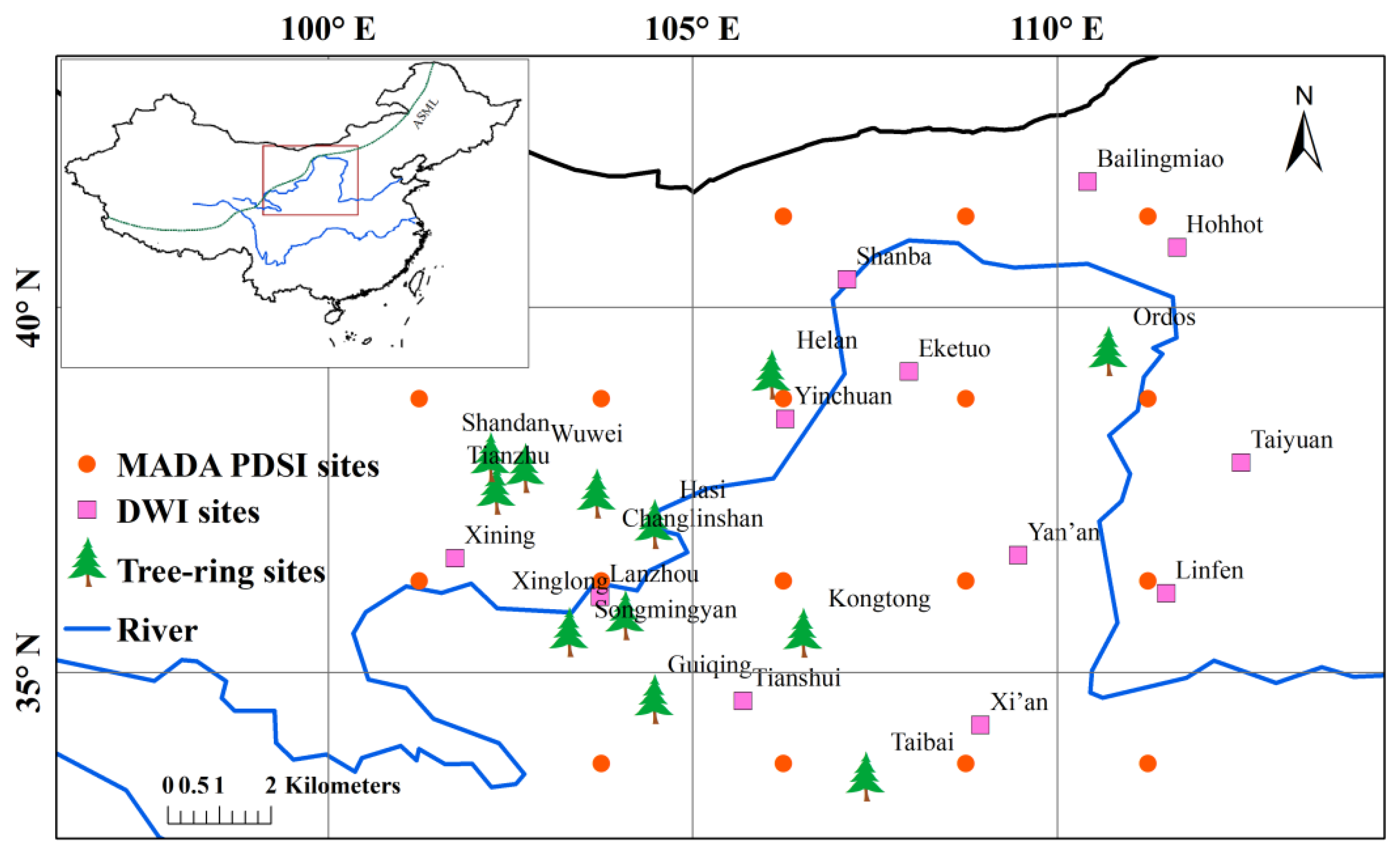


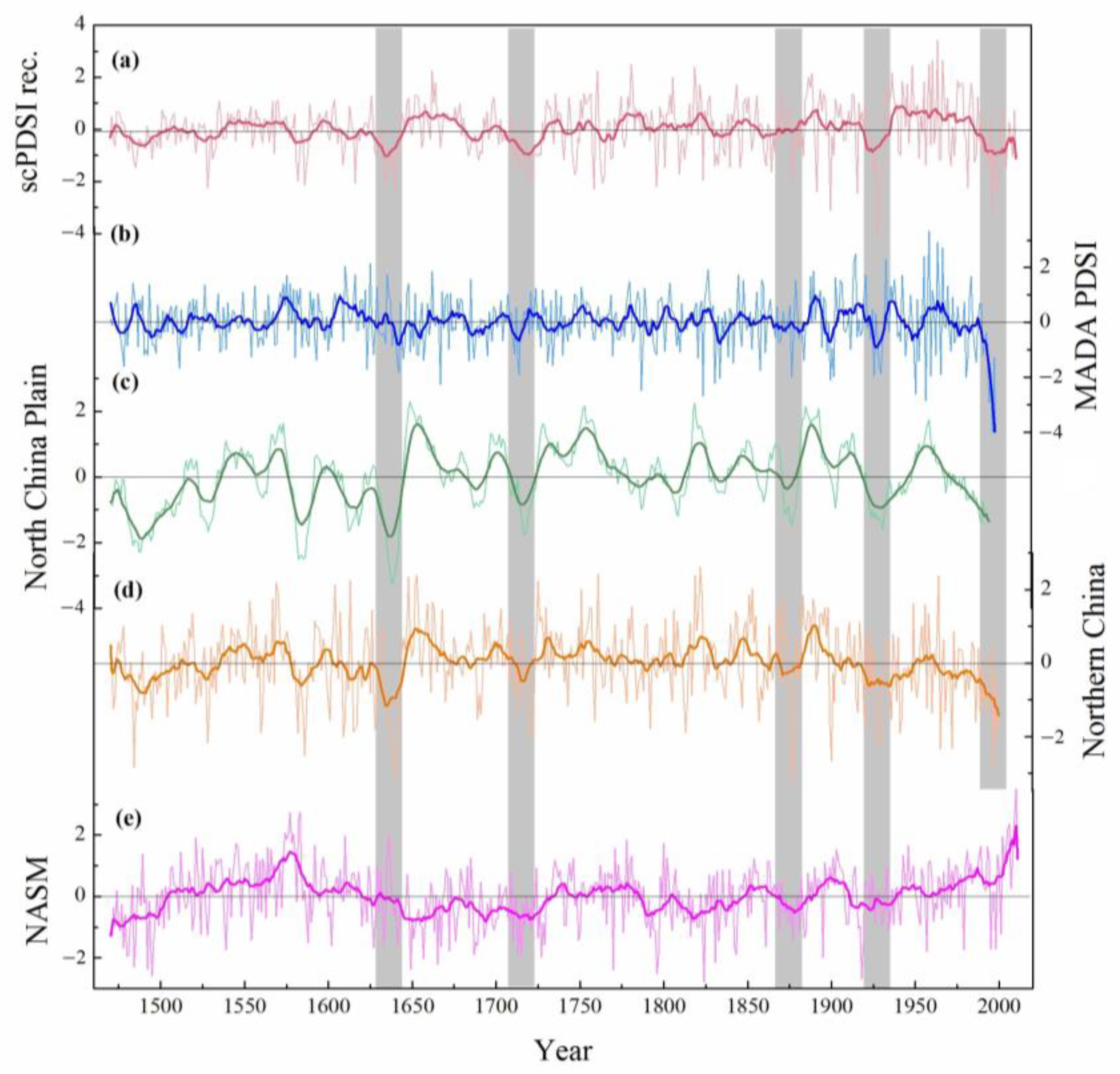
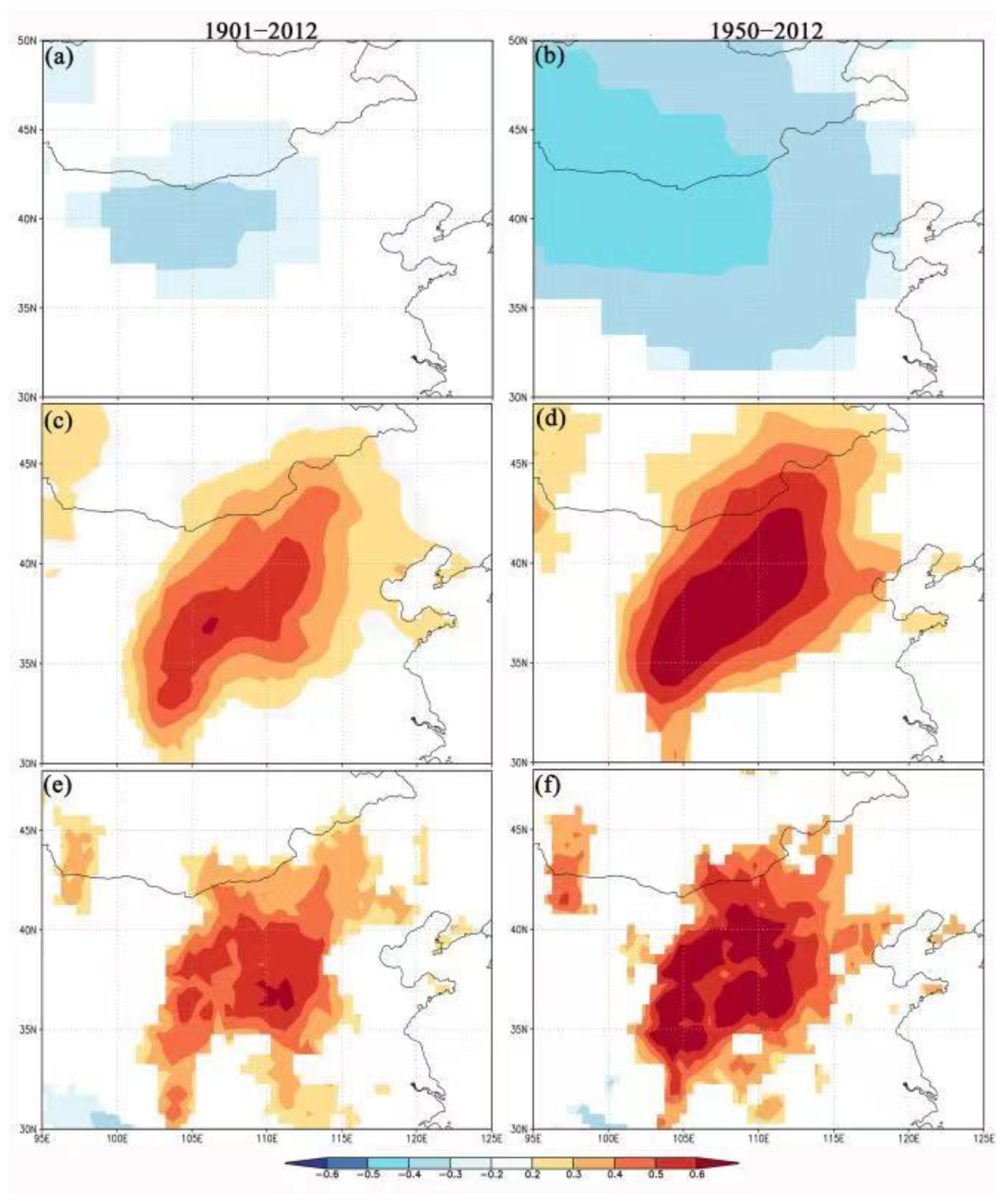
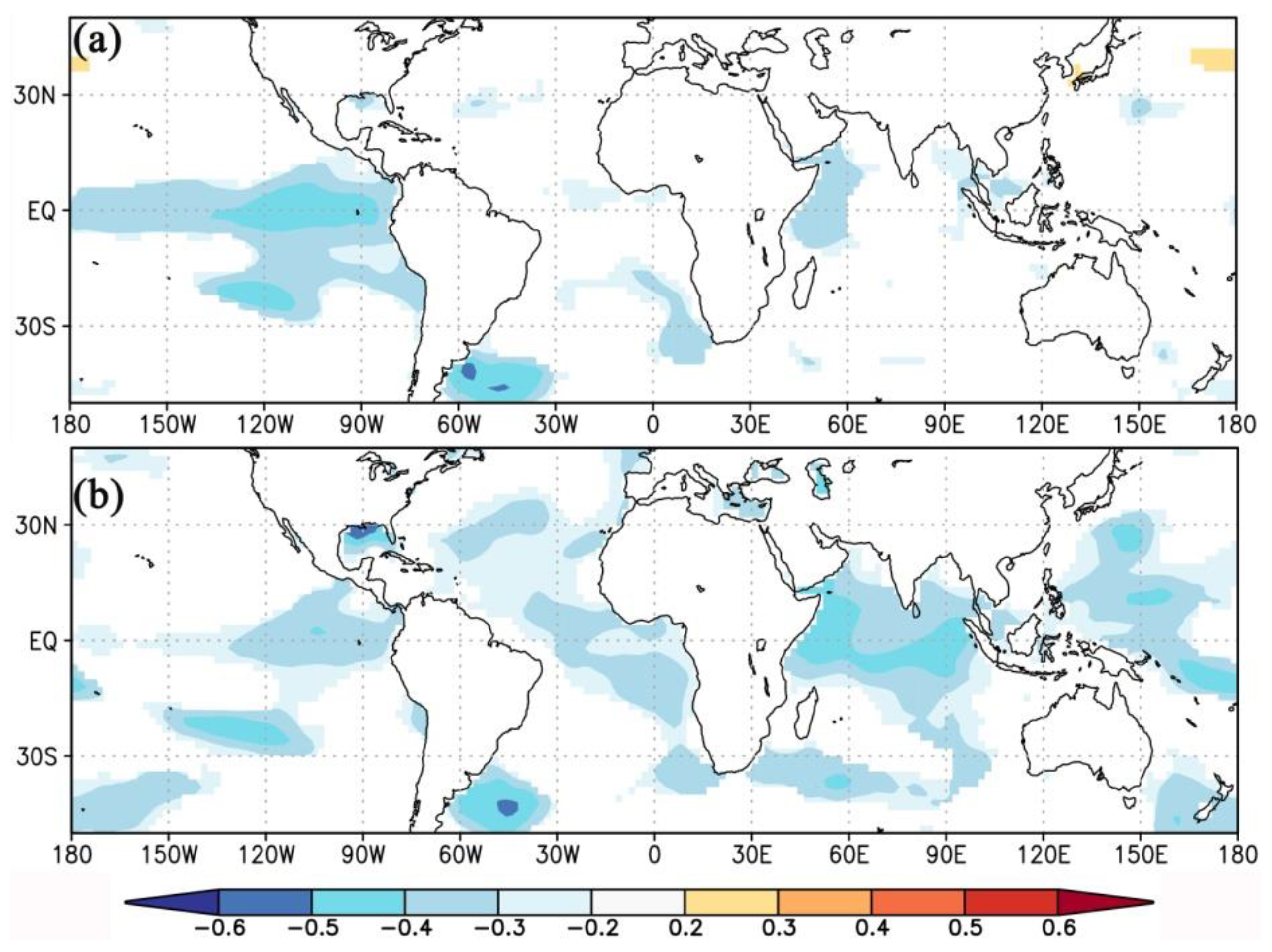
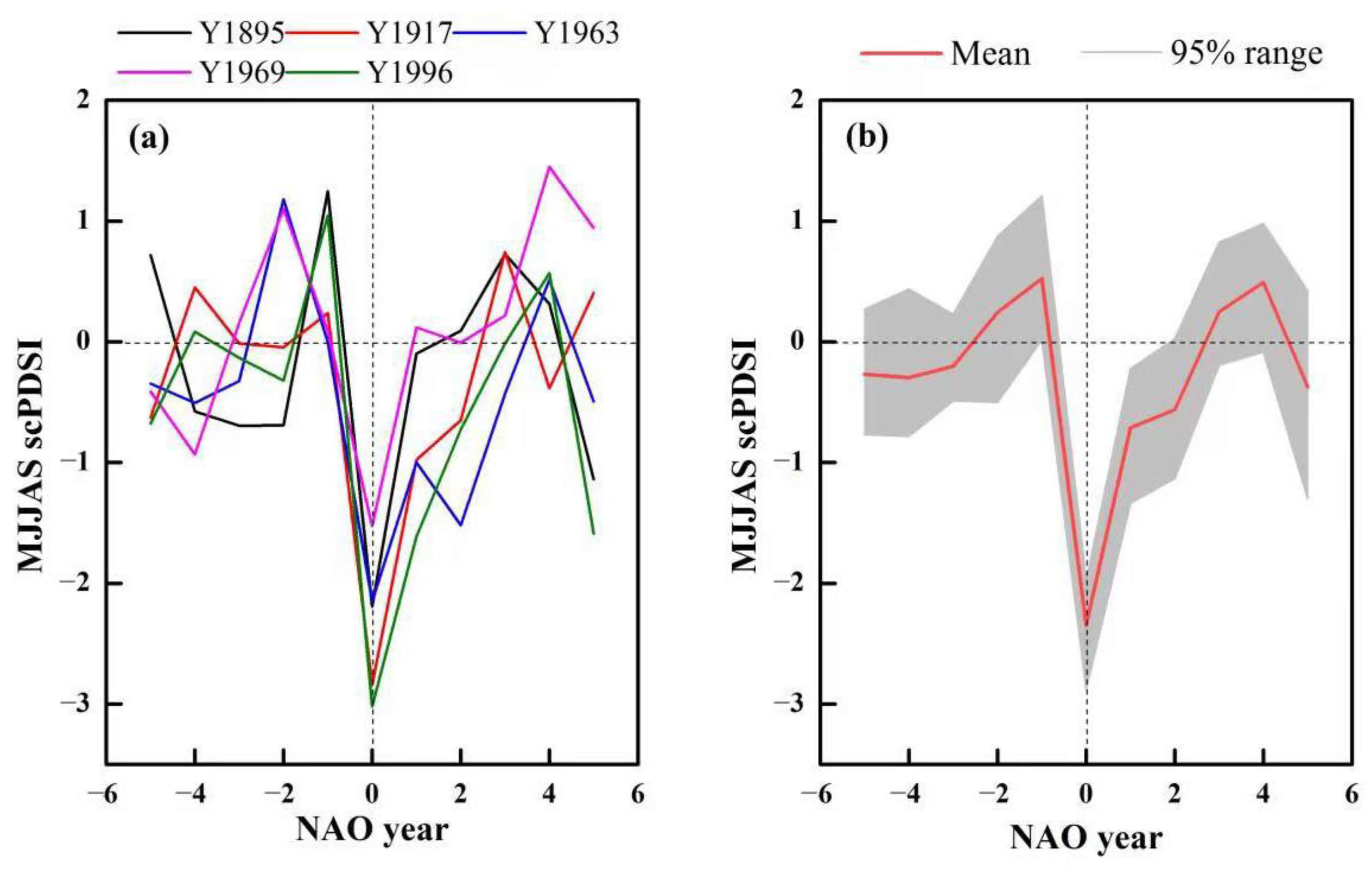
| Site | Lat. (°N) | Long. (°E) | Type | Period (AD) | Correlation Coefficient with scPDSI | Reference |
|---|---|---|---|---|---|---|
| Kongtong | 35.54 | 106.51 | TRW | 1615–2009 | 0.377 ** | [35] |
| Guiqing | 34.63 | 104.47 | TRW | 1618–2006 | 0.313 ** | [36] |
| Hasi | 37.03 | 104.47 | TRW | 1698–2012 | 0.453 ** | [37] |
| Helan | 39.08 | 106.08 | TRW | 1717–1999 | 0.296 ** | [38] |
| Taibai | 33.57 | 107.37 | TRW | 1740–2004 | −0.028 | [39] |
| Tianzhu | 37.50 | 102.3 | TRW | 1750–2009 | 0.197 * | [40] |
| Shandan | 37.95 | 102.22 | TRW | 1783–2006 | 0.242 * | [41] |
| Xinglong | 35.78 | 104.07 | TRW | 1794–2002 | 0.416 ** | [42] |
| Songmingyan | 35.55 | 103.3 | TRW | 1804–2010 | 0.296 ** | [43] |
| Ordos | 39.40 | 110.7 | δ18O | 1808–2012 | −0.420 ** | [44] |
| Wuwei | 37.80 | 102.7 | TRW | 1856–2009 | 0.271 ** | [45] |
| Changlinshan | 37.45 | 103.68 | TRW | 1860–2000 | 0.281 ** | [46] |
Disclaimer/Publisher’s Note: The statements, opinions and data contained in all publications are solely those of the individual author(s) and contributor(s) and not of MDPI and/or the editor(s). MDPI and/or the editor(s) disclaim responsibility for any injury to people or property resulting from any ideas, methods, instructions or products referred to in the content. |
© 2023 by the authors. Licensee MDPI, Basel, Switzerland. This article is an open access article distributed under the terms and conditions of the Creative Commons Attribution (CC BY) license (https://creativecommons.org/licenses/by/4.0/).
Share and Cite
Kang, S.; Liu, J.; Wang, J. Hydroclimate Variations across North-Central China during the Past 530 Years and Their Relationships with Atmospheric Oscillations. Forests 2023, 14, 640. https://doi.org/10.3390/f14030640
Kang S, Liu J, Wang J. Hydroclimate Variations across North-Central China during the Past 530 Years and Their Relationships with Atmospheric Oscillations. Forests. 2023; 14(3):640. https://doi.org/10.3390/f14030640
Chicago/Turabian StyleKang, Shuyuan, Jingjing Liu, and Jianglin Wang. 2023. "Hydroclimate Variations across North-Central China during the Past 530 Years and Their Relationships with Atmospheric Oscillations" Forests 14, no. 3: 640. https://doi.org/10.3390/f14030640
APA StyleKang, S., Liu, J., & Wang, J. (2023). Hydroclimate Variations across North-Central China during the Past 530 Years and Their Relationships with Atmospheric Oscillations. Forests, 14(3), 640. https://doi.org/10.3390/f14030640





